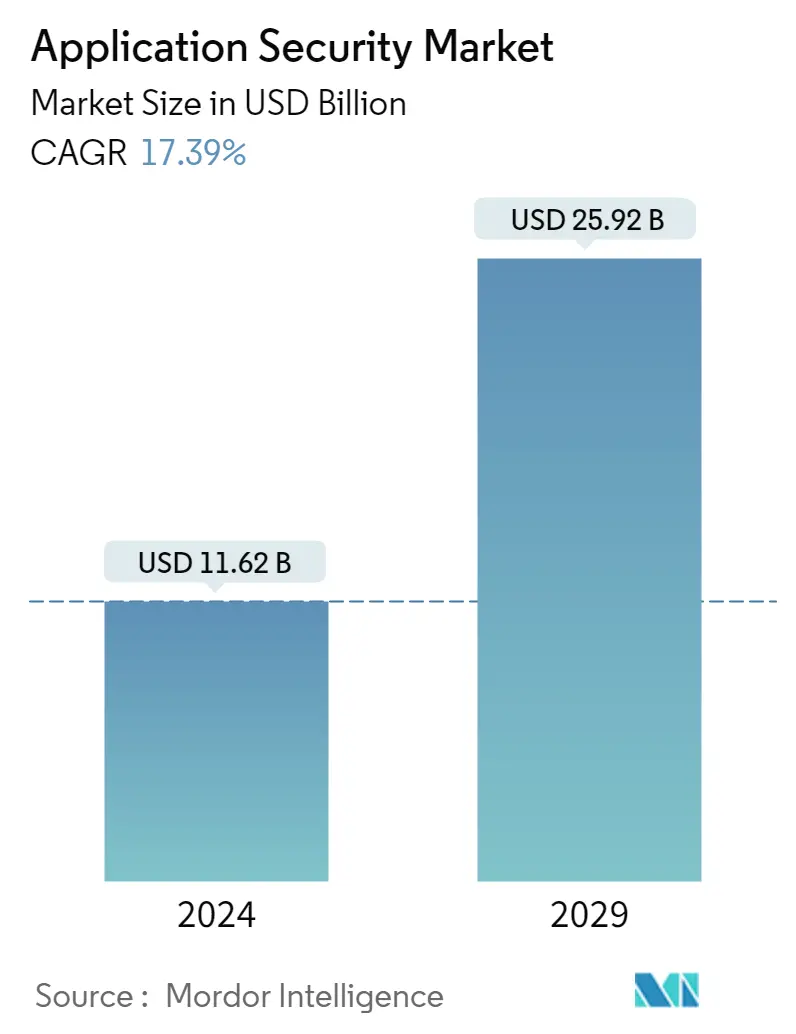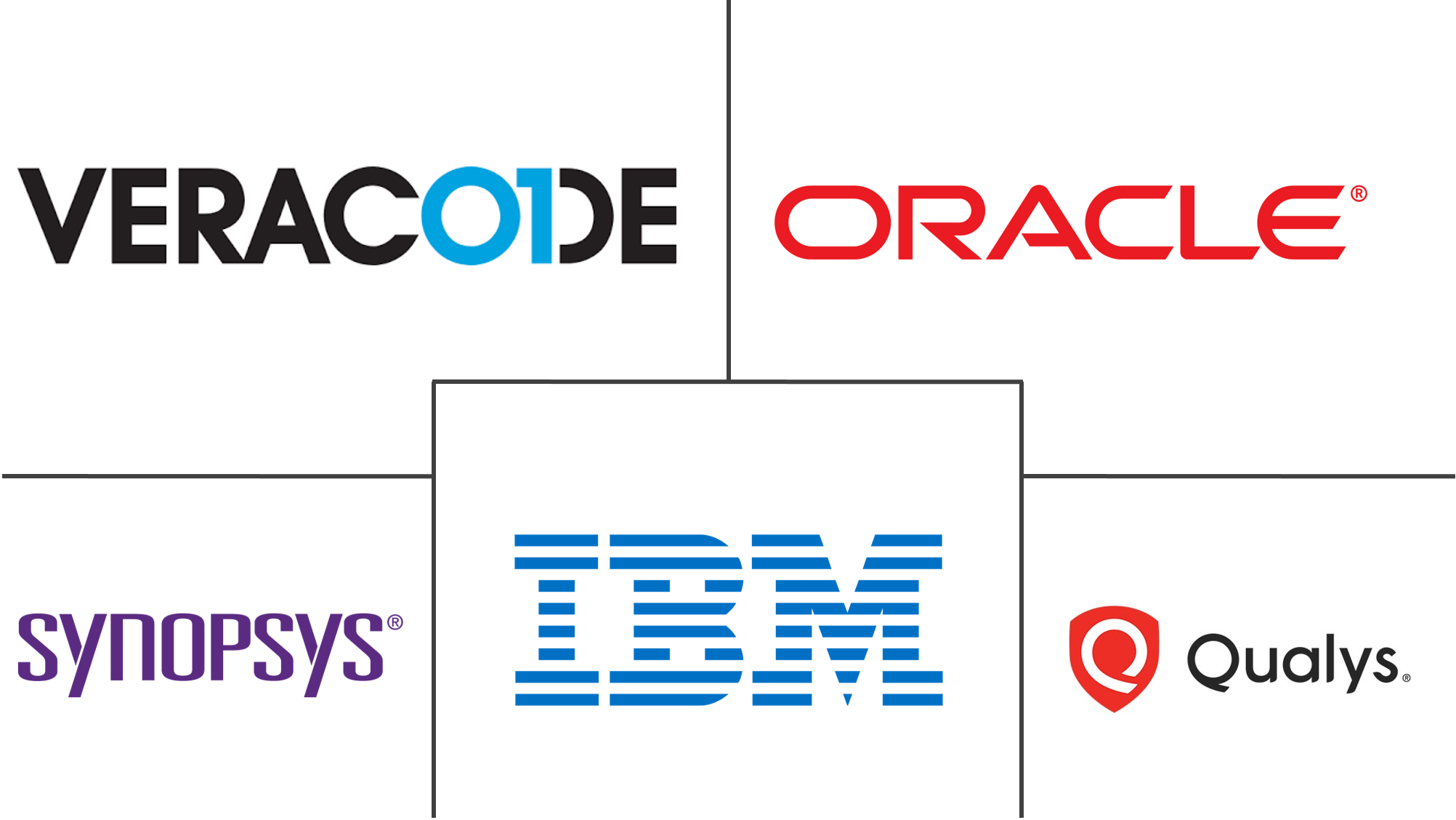Market Size of Application Security Industry

| Study Period | 2019 - 2029 |
| Market Size (2024) | USD 11.62 Billion |
| Market Size (2029) | USD 25.92 Billion |
| CAGR (2024 - 2029) | 17.39 % |
| Fastest Growing Market | Asia Pacific |
| Largest Market | North America |
Major Players
*Disclaimer: Major Players sorted in no particular order |
Application Security Market Analysis
The Application Security Market size is estimated at USD 11.62 billion in 2024, and is expected to reach USD 25.92 billion by 2029, growing at a CAGR of 17.39% during the forecast period (2024-2029).
Application security has become necessary with an increasing number of companies looking to develop their apps, purchase a record number of applications, and incorporate open-source code into their applications. The vulnerabilities and risks associated with these applications have risen exponentially.
- The application security systems reduce the security risks involved in the different operations of various applications, such as web and mobile applications. It has been anticipated that web applications would remain the most frequent cause of confirmed breaches, with organizations majorly connecting to various business-critical applications. On the internet, a breach risk has been continuously increasing.
- Despite the increasing frequency of data breaches and cybercrime, several types of research indicate that more money or attention still needs to be given to information security, specifically cybersecurity, in the workplace. When applications are used only within business-critical activities, such as payment-related activities or ordering goods and services, enterprises leave thousands of applications unused.
- Moreover, the usage of machine learning and artificial intelligence in mobile and web-based security processes bolsters the demand for the application security market. Application security encompasses mobile and web applications that go through several stages of the security development cycle, such as security coding and design.
- Several AI-specific fields, like ML and expert systems, could enhance application security by generating, forecasting, or applying inferences to identify security vulnerabilities, anticipate security risks, and provide security code remediation recommendations. Moreover, security professionals are also using these technologies to automate attack risk identification and code review. Numerous firms, like BR Softech, FuGen X, and USM Business Systems, use ML and AI for application development projects.
- With the outbreak of COVID-19, almost the majority of the organization had shifted to work from the home model due to the lockdown and social distancing measures that created a significant demand for managing the application and monitoring the application aspect remotely. For instance, last year, OpsRamp expanded its network, UC monitoring for the WFH world with new functionality in the OpsRamp platform that offers solutions providers a way to help customers manage hybrid and multi-cloud IT environments and meet the needs of work-from-home employees as demand for cloud applications, unified communications (UC) and collaboration tools, video conferencing, and other IT resources had increased significantly.
Application Security Industry Segmentation
Application security encompasses measures taken to improve the security of an application, often by finding, fixing, and preventing security vulnerabilities. Different techniques surface security vulnerabilities at various stages of an application's lifecycle, such as design, development, deployment, upgrade, and maintenance.
The Application Security Market is segmented by Application (Web, Mobile), Component (Services (Managed and Professions), Deployment (Cloud, On-Premise)), Organization Size (SMEs, Large Enterprises), Type of Security Testing (SAST, DAST, IAST, RASP), End-user Vertical (Healthcare, BFSI, Education, Retail, Government), and Geography (North America, Europe, Asia-Pacific, Latin America, and Middle East and Africa).
The market sizes and forecasts are provided in terms of value (USD billion) for all the above segments.
| Application | |
| Web Application Security | |
| Mobile Application Security |
| Component | ||||
| ||||
|
| Organization Size | |
| Small and Medium Enterprises | |
| Large Enterprises |
| Types of Security Testing | |
| Static Application Security Testing (SAST) | |
| Dynamic Application Security Testing (DAST) | |
| Interactive Application Security Testing (IAST) | |
| Run-Time Application Self Protection (RASP) |
| End-user Industry | |
| Healthcare | |
| BFSI | |
| Education | |
| Retail | |
| Government | |
| Other End-user Verticals |
| Geography | |
| North America | |
| Europe | |
| Asia-Pacific | |
| Latin America | |
| Middle East & Africa |
Application Security Market Size Summary
The application security market is experiencing significant growth, driven by the increasing need for robust security measures as companies expand their digital footprints through app development and the integration of open-source code. The rise in vulnerabilities and risks associated with web and mobile applications has made application security systems essential. These systems are designed to mitigate security risks across various application operations, with web applications being a primary focus due to their frequent association with data breaches. The market is further bolstered by advancements in machine learning and artificial intelligence, which enhance security processes by identifying vulnerabilities and automating risk assessments. The shift to remote work during the COVID-19 pandemic has also accelerated demand for application security solutions, as organizations seek to manage and monitor applications in hybrid and multi-cloud environments.
In the retail sector, the application security market is driven by the increasing digitization and the need for secure mobile and web-based shopping experiences. Retailers are investing in technologies like mobile apps and in-app shopping capabilities to enhance customer engagement and personalize shopping experiences. The proliferation of specialty software applications in retail, coupled with supportive government regulations, is expected to further propel market growth. Similarly, the financial services industry is witnessing a surge in cyber threats, prompting a greater focus on application security to protect against financial crimes. Government initiatives, such as the State and Local Cybersecurity Grant Program, are also playing a crucial role in promoting application security solutions. The market is characterized by fragmentation, with key players like IBM, Oracle, and Synopsys Inc. leading innovations to maintain competitive advantage. Recent developments, such as acquisitions and new product offerings, underscore the dynamic nature of the market as companies strive to enhance their security capabilities.
Application Security Market Size - Table of Contents
-
1. MARKET DYNAMICS
-
1.1 Market Overview
-
1.2 Industry Attractiveness - 'Porter's Five Forces Analysis'
-
1.2.1 Threat of New Entrants
-
1.2.2 Bargaining Power of Buyers/Consumers
-
1.2.3 Bargaining Power of Suppliers
-
1.2.4 Threat of Substitute Products
-
1.2.5 Intensity of Competitive Rivalry
-
-
1.3 Industry Attractiveness - Porter's Five Forces Analysis
-
-
2. MARKET SEGMENTATION
-
2.1 Application
-
2.1.1 Web Application Security
-
2.1.2 Mobile Application Security
-
-
2.2 Component
-
2.2.1 Service
-
2.2.1.1 Managed
-
2.2.1.2 Professional
-
-
2.2.2 Deployment (Solution)
-
2.2.2.1 Cloud
-
2.2.2.2 On-premise
-
-
-
2.3 Organization Size
-
2.3.1 Small and Medium Enterprises
-
2.3.2 Large Enterprises
-
-
2.4 Types of Security Testing
-
2.4.1 Static Application Security Testing (SAST)
-
2.4.2 Dynamic Application Security Testing (DAST)
-
2.4.3 Interactive Application Security Testing (IAST)
-
2.4.4 Run-Time Application Self Protection (RASP)
-
-
2.5 End-user Industry
-
2.5.1 Healthcare
-
2.5.2 BFSI
-
2.5.3 Education
-
2.5.4 Retail
-
2.5.5 Government
-
2.5.6 Other End-user Verticals
-
-
2.6 Geography
-
2.6.1 North America
-
2.6.2 Europe
-
2.6.3 Asia-Pacific
-
2.6.4 Latin America
-
2.6.5 Middle East & Africa
-
-
Application Security Market Size FAQs
How big is the Application Security Market?
The Application Security Market size is expected to reach USD 11.62 billion in 2024 and grow at a CAGR of 17.39% to reach USD 25.92 billion by 2029.
What is the current Application Security Market size?
In 2024, the Application Security Market size is expected to reach USD 11.62 billion.

